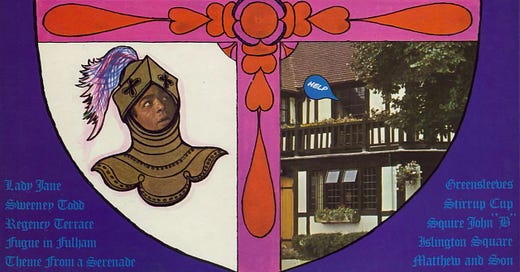A Psychedelic Session with the In-Keepers
Wen studio musicians decide to record a wacky baroque pop album
The In-Keepers (not to be confused with a sunshine pop band by the same name, though their single "The Cobweb Threads of Autumn" is well worth a listen) were a one-off studio band assembled by Ray Davies—not the Kinks one, but the Welsh trumpet player, who for the most part plied his trade as a very much in-demand session musician, producer, and arranger and mastermind behind the very accomplished studio band The Button Down Brass, which was conceived as Britain's answer to Herb Alpert and the Tijuana Brass (their answer was to cover a lot of Herb Alpert songs). Like many British studio musicians that came to prominence in the 1950s-'70s, Davies got his start in a military band. He later conducted the BBC Radio Orchestra played trumpet on fellow Welshman Tom Jones' "It's Not Unusual" and Petula Clark's "Downtown" (written and arranged by fellow library and session studio legend Tony Hatch), and lent the occasion word of advice to the Beatles and the Rolling Stones.
As for who took part in the In-Keepers session, there's not much info to be found other than the participation of Davies himself and Terry Brown (who engineered Jimi Hendrix's Axis: Bold as Love album and a ton of Rush albums). If I had to guess, Davies and Brown were hanging around the studio one day, a few other musicians were there, and someone was like, "Why not?' It was 1968. A lot of people were high. Their Satanic Majesties Request (the Stones' answer to the Beatles Sgt. Pepper's Lonely Hearts Club Band) had come out just a few months earlier, everyone was wearing candy-colored Victorian and Edwardian clothes, and there were lots of soft psychedelic pop songs about vicars with lovely daughters, recorded by mop-topped bands whose album cover was a photo of them either standing under a large tree or in front of a crumbling stone wall—which, if it had been 1963 instead of 1968, they would have been photographed jumping off of. It makes sense, then, that a bunch of talented session musicians would give it a go.
The result is the kind of light-hearted, harpsichord-heavy instrumental baroque pop that would play in an episode of The Monkees in which Peter inherits a haunted mansion and makes lovestruck puppy faces at the ghost of a French mademoiselle in Marie Antoinette attire. In the end, she'll be revealed to be the daughter of the conniving real estate agent who wants to swindle Peter out of his inheritance—although she really did fall for him. Although heartbroken, Peter will pep up when Mickey pats him on the back and takes him out for a hot dog.
Sorry, went down a rabbit hole there. I really want to see that episode of The Monkees happen, though. Oh wait, that episode of The Monkees basically did happen. "Monkee See, Monkee Die." Only it was Davy who falls in love, and not with a French ghost. But still, there was a lot of harpsichord, and this happens, so close enough.
Anyway, the album opens with, of all things, a poppy cover of "In An Eighteenth Century Drawing Room," recorded in 1939 by the Raymond Scott Quintent, which was itself Scott's tribute to Mozart. Scott, incidentally, went on to be an electronic music pioneer, and many of his frenetic easy listening style songs found their way into cartoons, most notably "Powerhouse," a favorite of Loony Tunes). The second track, "Sweeney Todd," builds itself out of the tune of "Swing Low, Sweet Chariot." I can't claim to know exactly what the hell is going on. To confuse the situation further, the song features a fuzzed-out guitar that makes it all sound like the theme song to a Western show. But whatever, man. It was the late '60s. Things got weird.
A breezy cover of the Rolling Stones' "Lady Jane" makes more sense and is pretty good. That song was already pretty twee. "The Old Lady of Threadneedle Street" sounds like the theme from a 1960s ITV spy series, highlighted by a groovy beat and some twangy guitar. There's also a cover of Cat Stevens' "Matthew and Son," and the arrangement of "Greensleeves" that pretty much every psych-folk and baroque pop band was required by royal decree to perform, although the In-Keepers turn it into a pretty swinging affair. Davies and his mystery players close the album with a cover of "Sloop John B" they call "Squire John B." Because why the hell not? By this time, the mushrooms have taken you through the magic hedge anyway.
Most songs, even the ones that aren't covers, will remind you of some other song, only with way more harpsichord. It never quite rises above the level of frivolous novelty, but sometimes frivolous novelty is fine. If you like baroque pop and easygoing light psychedelia, which I do, then the In-Keepers’ strange little album will put a smile on your face, even if your heart gets broken by a haunted mansion's pretty ghost lady or a vicar's lovely daughter. The players are good, the music is pleasant and upbeat, and everyone is happy. It's all a bit like twirling around in a field of poppies while wearing a bent top hat.




